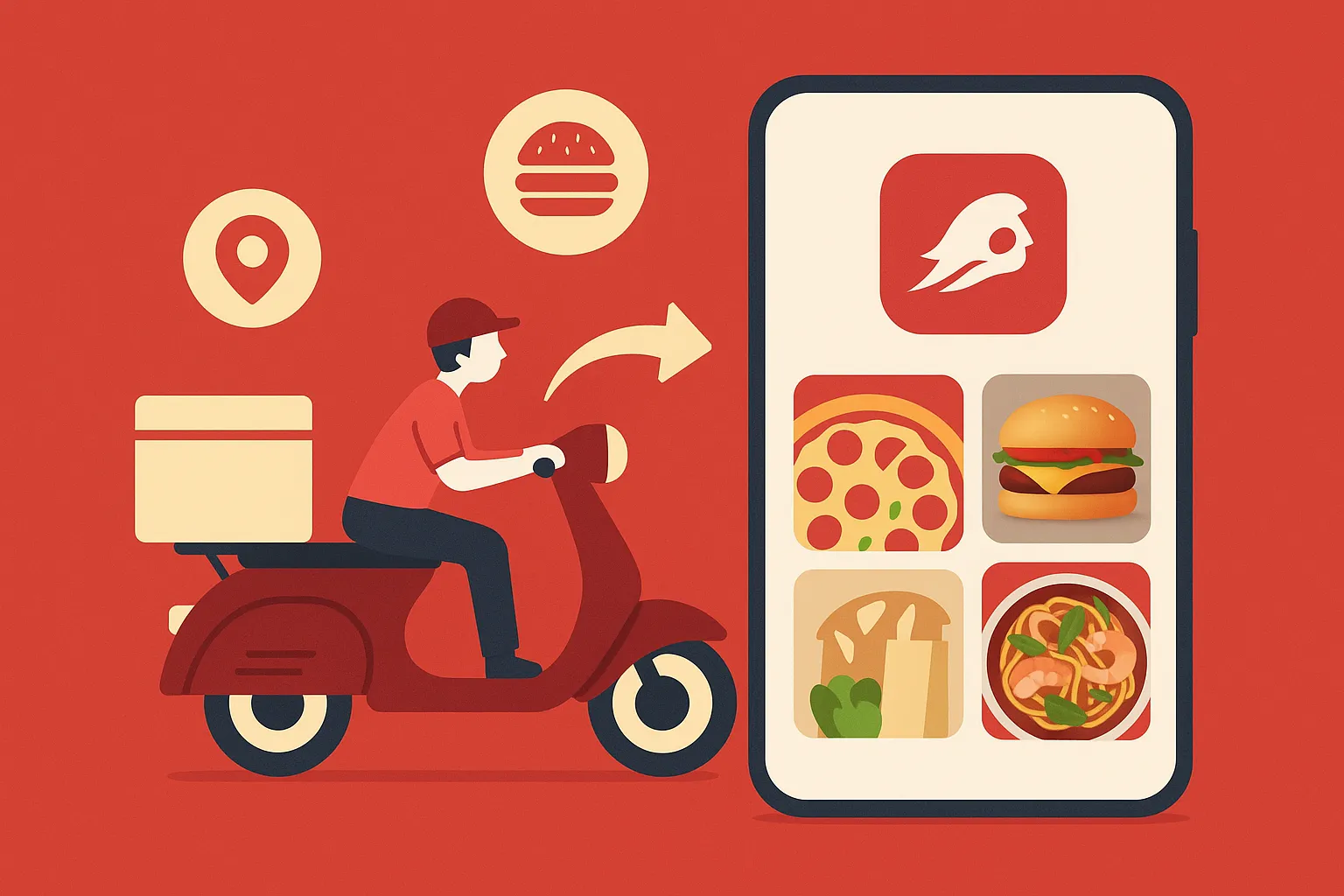Delivery Hero has grown into one of the world’s largest online food delivery platforms, operating in over 70 countries. Its business model is a blueprint for any entrepreneur aiming to build a high-volume, multi-market delivery app.
Why is the Delivery Hero business model of Delivery Hero worth studying? Because it demonstrates how a marketplace can scale quickly, leverage local partnerships, and diversify revenue streams beyond simple order commissions. Whether you plan to launch a regional food delivery app or expand globally, there are lessons here about logistics, monetization, and platform design that can inspire your roadmap.
What is Delivery Hero & How It Works
Delivery Hero is an online food ordering and delivery marketplace. It connects hungry customers with restaurants and delivery partners through a single app and website. It streamlines everything from browsing menus to tracking orders in real time. With a few taps, users can discover restaurants, place orders, and get meals delivered to their doorstep.
What Problem Does It Solve?
Before apps like Delivery Hero, ordering food involved calling restaurants, manually checking menus, and waiting without clear delivery tracking. Delivery Hero solves this by:
- Aggregating thousands of restaurants in one platform
- Enabling instant ordering with secure online payments
- Providing real-time delivery tracking
It simplifies discovery, ordering, and delivery for both customers and restaurants.
Who Uses It?
- Consumers who want quick, reliable meal delivery
- Restaurants seeking to boost orders without managing their own delivery fleet
- Riders/Couriers looking for flexible gig work
How Does the App Work Operate?
Delivery Hero works as a two-sided marketplace:
- Customers browse menus, place orders, and pay through the app
- Restaurants receive orders and prepare meals
- Couriers pick up the orders and deliver them to customers
The platform manages payments, logistics optimization, and customer support while earning commissions and service fees on each transaction.
Read More : What is Delivery Hero App and How Does It Work?
Busy professionals needing quick delivery
Delivery Hero’s business model is built around several core customer segments. Each plays a crucial role in driving order volume and platform revenue:
1. Urban Consumers
People living in cities and suburban areas who:
- Value convenience and time savings
- Want access to a wide variety of cuisines
- Frequently use mobile apps for ordering
2. Busy Professionals
Working individuals who:
- Order lunch or dinner to the office or home
- Prefer cashless, fast transactions
- Are willing to pay delivery fees for reliability
3. Families & Groups
Households ordering meals together:
- Group ordering features make it easier to split meals
- Larger average order values increase profitability
4. Restaurants and Food Chains
Independent restaurants and franchise brands who:
- Want to expand their delivery reach without building in-house logistics
- Use Delivery Hero as a marketing and sales channel
5. Couriers and Riders
Freelance couriers who:
- Seek flexible earning opportunities
- Rely on Delivery Hero’s technology to access delivery gigs
These diverse audiences fuel consistent demand and supply, creating a self-reinforcing marketplace.
Features that Support the Business Model
Delivery Hero’s success depends on a well-designed platform that drives orders, supports partners, and generates revenue. Here are the key features that make this possible:
1. Restaurant Marketplace
A curated listing of thousands of restaurants with:
- Search filters by cuisine, rating, price, and delivery time
- Menu photos and detailed descriptions
- Exclusive promotions to incentivize orders
2. Real-Time Order Tracking
Customers can:
- Follow their order status from preparation to doorstep
- Receive ETA updates and courier location on a live map
This transparency builds trust and reduces support inquiries.
3. Integrated Payment Gateway
Supports multiple payment methods:
- Credit/debit cards
- Digital wallets
- Cash on delivery (in select regions)
This increases conversion rates and simplifies transactions.
4. Delivery Logistics Engine
A proprietary dispatch system that:
- Optimizes courier assignment
- Reduces delivery times
- Balances supply and demand across busy zones
5. Loyalty and Referral Programs
Customers earn points or credits for:
- Placing repeat orders
- Referring friends
- Participating in seasonal promotions
These programs drive retention and viral growth.
6. Restaurant Management Dashboard
Partners get tools to:
- Manage menus and pricing
- Monitor order volumes
- Access analytics and sales reports
This empowers restaurants to improve performance and stay engaged.
7. Courier App
For riders, the app provides:
- Smart routing and delivery instructions
- Earnings tracking
- Flexible shift scheduling
This keeps the supply side active and responsive.
Read More : Best Delivery Hero Clone Scripts in 2025: Features & Pricing Compared
Revenue Streams of Delivery Hero
Delivery Hero has built a multi-layered revenue model that goes beyond simple order commissions. Here’s a breakdown of the main streams that power their earnings:
| Revenue Stream | How It Works |
| Commission Fees | Percentage charged to restaurants on each order (typically 10–30%) |
| Delivery Fees | Fees paid by customers for each delivery, often variable based on distance and speed |
| Subscription Programs | Monthly memberships offering free or discounted delivery (e.g., loyalty plans) |
| Advertising & Sponsored Listings | Restaurants pay for promoted placement in search results or app banners |
| Service Fees | Small fees applied to each order to cover platform costs |
| White Label Logistics | Providing delivery services for other brands or partners |
Quick Overview
- Commission Fees
- Core revenue driver.
- Encourages restaurants to scale sales through the platform.
- Core revenue driver.
- Delivery Fees
- Helps offset courier costs.
- Dynamic pricing maximizes profitability during peak hours.
- Helps offset courier costs.
- Subscription Programs
- Generates predictable recurring revenue.
- Increases customer loyalty.
- Generates predictable recurring revenue.
- Advertising & Sponsored Listings
- High-margin income from restaurants competing for visibility.
- High-margin income from restaurants competing for visibility.
- Service Fees
- Typically a fixed percentage or flat fee per transaction.
- Typically a fixed percentage or flat fee per transaction.
- White Label Logistics
- Extends Delivery Hero’s delivery network to serve third parties.
- Extends Delivery Hero’s delivery network to serve third parties.
This diversified approach ensures revenue stability and resilience even if order volumes fluctuate seasonally
Read More : Revenue Model of Delivery Hero: Inside the Business Behind the Global Food Delivery Giant
Cost Structure to Run Delivery Hero
Running a platform like Delivery Hero requires substantial investment to maintain operations, growth, and customer satisfaction. Here are the main expense categories:
1. Courier Payments
- The largest cost center.
- Payments to freelance delivery riders, including per-delivery fees and incentives.
2. Technology Infrastructure
- Hosting, server costs, and app maintenance.
- Continuous development to improve features, speed, and security.
3. Customer Support
- Multilingual support teams handling order issues, refunds, and complaints.
- Chatbots and AI tools to reduce response times.
4. Marketing and Promotions
- Customer acquisition campaigns (digital ads, discounts, referrals).
- Restaurant onboarding incentives to grow the marketplace.
5. Operations and Logistics
- Regional teams managing courier fleets and partner relations.
- Costs related to delivery hubs or dark kitchens in select markets.
6. Regulatory and Compliance
- Licensing fees and legal expenses.
- Data privacy and labor law compliance in each country of operation.
These costs are balanced carefully against revenue streams to keep margins healthy while scaling globally.
Read more : DeliveryHero App Marketing | Delivering Growth That Last
Latest Innovations and Strategic Updated
Delivery Hero continues to evolve its business model to stay competitive and meet rising customer expectations. Here are some notable updates and strategic shifts happening in 2024–2025:
1. Dark Stores and Quick Commerce
- Expanded investment in dark stores to power ultra-fast grocery delivery (15–30 minutes).
- Integration of quick commerce within the main app to cross-sell groceries and restaurant meals.
2. Sustainability Initiatives
- Rollout of electric bikes and scooters in key cities.
- Pilot programs for reusable packaging to reduce waste.
3. AI-Powered Dispatch Optimization
- Enhanced machine learning algorithms for courier routing.
- Improved delivery time predictions and reduced idle time for riders.
4. Dynamic Pricing
- Wider implementation of surge delivery fees based on demand spikes.
- Personalized discounts driven by AI-based customer segmentation.
5. Restaurant Tech Partnerships
- New integrations with point-of-sale systems to automate order flow.
- Tools to help restaurants manage inventory and forecast demand.
6. Subscription Tiers
- Introduction of premium subscription options offering:
- Priority delivery slots
- Exclusive restaurant discounts
- Lower service fees
- Priority delivery slots
These innovations aim to strengthen customer loyalty, increase order frequency, and improve profitability across markets.
Takeaways for Startup Founders
If you’re planning to build a delivery marketplace inspired by Delivery Hero, there are valuable lessons you can apply:
1. Start with Focus, Then Expand
Delivery Hero succeeded by first dominating regional markets before scaling internationally. Launch in one or two cities, refine operations, and then expand step by step.
2. Diversify Revenue Early
Don’t rely solely on commissions. Integrate:
- Delivery fees
- Advertising options for restaurants
- Subscription programs for customers
This makes your business more resilient to seasonal fluctuations.
3. Invest in Logistics Technology
A seamless delivery experience is what keeps customers loyal. Prioritize:
- Real-time order tracking
- Smart routing algorithms
- Efficient courier onboarding
4. Build Strong Restaurant Partnerships
Your supply side drives customer choice. Offer:
- Transparent commissions
- Tools to track performance
- Co-marketing opportunities
This keeps restaurants engaged and motivated.
5. Differentiate with Experience
Fast delivery alone won’t set you apart. Use loyalty programs, sustainability initiatives, or niche cuisine categories to stand out.
Read more : Reasons startup choose our Delivery Hero clone over custom development
Conclusion :
Delivery Hero’s business model is a masterclass in how to build and scale a global delivery marketplace. By combining diverse revenue streams, smart logistics, and a relentless focus on customer experience, they’ve become a dominant force in the industry.
If you’re an entrepreneur aiming to launch your own food delivery platform, there’s no reason to start from scratch. At Miracuves, we specialize in building ready-made, customizable app clones inspired by industry leaders. Whether you want to replicate Delivery Hero’s success or carve out your own niche, our solutions can get you to market faster and more cost-effectively.
Ready to bring your food delivery idea to life?
Contact with Miracuves and let’s turn your vision into a high-growth reality.
FAQs :
1. How does Delivery Hero make money?
They earn through commissions on each order, delivery fees, subscriptions, advertising, service fees, and white-label logistics. This mix ensures steady income even when markets fluctuate.
2. What is quick commerce, and why is Delivery Hero investing in it?
Quick commerce means delivering groceries in 15–30 minutes using dark stores. Delivery Hero uses it to drive frequent orders and stay ahead of rapid delivery competitors.
3. Is Delivery Hero a marketplace or a logistics company?
It’s both. They connect customers and restaurants while managing delivery through their own courier network and logistics technology.
4. How do restaurants benefit from partnering with Delivery Hero?
Restaurants gain new customers, in-app marketing, and performance insights. The added sales often outweigh the commission costs.
5. Can I build an app like Delivery Hero without huge investment?
Yes. With Miracuves, you can launch a branded, ready-made delivery app quickly and affordably, reducing both time and upfront costs.
Related Articles :








